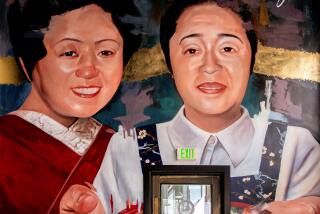Tokyo Raises Emperor’s Safety to Great Heights : Japan: A police blimp, barricades and thousands of officers join to combat any outburst as the nation prepares to enthrone Akihito on Monday.
- Share via
TOKYO — Buzzing overhead in the Japanese capital these days is a peculiar statement on the times: a police surveillance blimp painted with slogans admonishing citizens on the ground below to be on the lookout for guerrillas.
Loyal subjects of the emperor are asked to call a police hot line with tips on suspicious behavior. Not that one would need a telephone to reach authority in central Tokyo--the streets are thick with thousands of police officers, many in full riot gear.
Police barricades randomly snare passing motorists, and officers “request cooperation” to have a look in the trunk. Police halt pedestrians near the Imperial Palace to ask for identification. A foreign tourist might never suspect that Tokyo ranks among the safest cities in the world.
But this orgy of paramilitary vigilance is not without cause. The nation is about to embark on a rare exercise in self-congratulation: enthroning an emperor for the first time in 62 years in an elaborate series of ceremonies and rites--some ancient, some tedious, some full of modern pomp.
Leftist extremists, who oppose the imperial system because of its past association with totalitarianism, have vowed to spoil the fun with violence. The government, having invited dignitaries from 158 countries to attend the enthronement festival, is determined to keep things under control.
If all goes as planned, Emperor Akihito will take his seat atop the Chrysanthemum Throne on Monday and declare to the world his accession as Japan’s constitutional monarch. Prime Minister Toshiki Kaifu, in the climax of a ceremony broadcast live throughout the land, will lead his countrymen in three cheers of “ Banzai! “
Yet this will be but one crescendo in the prolonged ritual of Akihito’s coming of age as a Japanese emperor.
The process began hours after his father, Hirohito, died at the beginning of last year at age 87. The new emperor immediately received the three “imperial regalia”--a sword, a mirror and a curved jewel--symbolizing his authority. His transformation will not be complete, however, until dawn Nov. 23 after he passes the night in a mysterious ritual of communion with his mythical ancestor, the Sun Goddess.
The enthronement of Akihito--according to legend he is the 125th emperor in an unbroken line--means different things to different Japanese.
To a small minority of rightists, it reaffirms a unique tribal identity. To Japanese Christians and many intellectuals, it ominously confers legitimacy on an institution that was exploited by fascism and became the rallying point for repression and a war of aggression. To the conservative middle class, it preserves a rich cultural tradition and offers a vague source of national pride. To youth, the ritual is abstract, empty--and not all that interesting.
The enthronement also provides a good opportunity for some of the less developed countries to send official delegations to the world’s leading aid donor. Much like the “funeral diplomacy” that followed Hirohito’s interment rites in February, 1989, the international parade that has already begun to arrive in Tokyo is a tribute to Japan’s ascendancy and prestige as an economic giant.
Still, the auspicious occasion is not without shadows. Along with the fear of political terrorism--by right-wing extremists loyal to the emperor as well as by the leftist radicals bent on his downfall--and the unsettling memories from World War II, the rites have aroused a bitter debate over the constitutional separation of religious and state affairs.
Critics charge that the Daijo-sai ceremony Nov. 22-23 violates the constitution because it is essentially religious in nature, an activity that the government should not underwrite. The government has deemed it a “private ceremony of the imperial family,” as opposed to a state event like Monday’s ceremony, and therefore contends that public funding is legal.
Foreign guests are not invited to the Daijo-sai, but Kaifu and his Cabinet will attend the ancient ritual that many interpret as a deification of the emperor. A group of taxpayers filed suit in Osaka at the beginning of the month seeking an injunction to stop the torchlight ceremony. The judge delayed his decision until December.
The Imperial Household Agency, the bureaucracy attached to the emperor’s family, has issued official denials that the Daijo-sai in any way deifies or even transforms the emperor. Court officials are especially adamant in debunking the theory, popular among scholars of the Shinto religion, that the straw thrones used in the ritual have something to do with symbolic intercourse between the new emperor and the Sun Goddess.
Yoshio Karita, vice grand master of ceremonies, said officials decided to carry out the Daijo-sai exactly as it was done more than 1,000 years ago by Akihito’s ancestors--but for its “cultural aspects,” not for religious significance.
“We chose to keep the tradition intact,” Karita said. “You can’t just cut it off one day and say nothing of it after that.”
More to Read
Sign up for Essential California
The most important California stories and recommendations in your inbox every morning.
You may occasionally receive promotional content from the Los Angeles Times.











